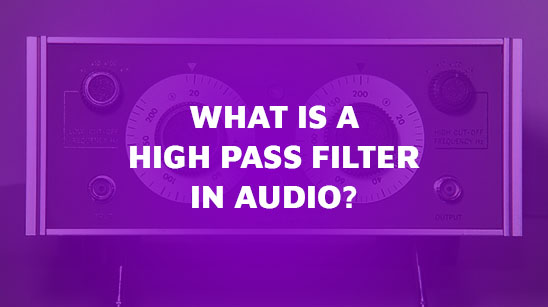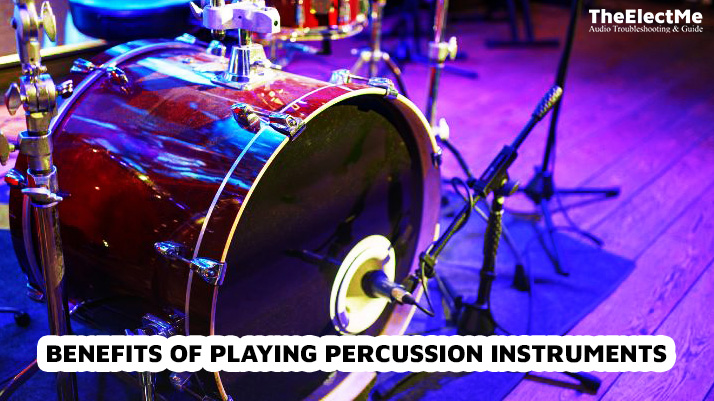So the question is, what is a high pass filter in audio? A high-pass filter is an audio processing technique that allows high-frequency signals to pass through while blocking or attenuating lower-frequency signals. It is called a “high pass” filter because it allows high-frequency signals to pass through while blocking or attenuating lower-frequency signals.

High-pass filters are commonly used in audio engineering to remove low-frequency noise or to shape the frequency response of an audio signal. They are often used in conjunction with low-pass filters, which allow low-frequency signals to pass through while blocking or attenuating higher-frequency signals.
Different Types of High Pass Filters in Audio
There are several different types of high-pass filters, including first-order and second-order filters, etc. The type of filter used will depend on the specific application and the desired frequency response. High-pass filters can be implemented using electronic circuits or software algorithms, and are often found in audio mixing consoles, equalizers, and other audio processing equipment.
There are several types of high-pass filters that can be used in audio engineering, including:
- First-order high pass filter: This is the most basic type of high pass filter. It is implemented using a single resistor and a single capacitor and is characterized by a single pole in the frequency response. A first-order high pass filter provides a 6 dB per octave roll-off above the cutoff frequency, which means that the amount of attenuation increases at a rate of 6 dB per octave as the frequency increases above the cutoff frequency.
- Second-order high pass filter: This type of high pass filter is implemented using two resistors and two capacitors, and is characterized by two poles in the frequency response. A second-order high pass filter provides a 12 dB per octave roll-off above the cutoff frequency, which means that the amount of attenuation increases at a rate of 12 dB per octave as the frequency increases above the cutoff frequency.
- Butterworth high pass filter: This is a type of high pass filter that is characterized by a flat response in the passband and a smooth roll-off in the stopband. Butterworth high pass filters are commonly used in audio applications because they provide a smooth and even frequency response.
- Chebyshev high pass filter: This is a type of high pass filter that is characterized by a steeper roll-off in the stopband compared to a Butterworth filter. Chebyshev high pass filters are often used when a sharp cutoff is desired.
- Bessel high pass filter: This is a type of high pass filter that is characterized by a linear phase response. Bessel high pass filters are often used in applications where phase distortion is a concern.
- Elliptic high pass filter: This is a type of high pass filter that is characterized by a very steep roll-off in the stopband. Elliptic high-pass filters are often used when a very sharp cutoff is desired, but they can introduce significant phase distortion.
What Does A High-pass Filter Sound Like?
The sound of a high-pass filter will depend on the specific characteristics of the filter and the audio signal being processed. In general, applying a high pass filter to an audio signal will reduce low-frequency content, which can have a number of different effects on the overall sound.
If the cutoff frequency of the high pass filter is set very low, the filter may have little or no effect on the sound of the signal. As the cutoff frequency is increased, the amount of attenuation at low frequencies will increase, resulting in a progressively greater reduction in low-frequency content.
At higher cutoff frequencies, the high pass filter will begin to have a more pronounced effect on the signal’s sound. The sound may become thinner, more focused, or more defined, depending on the specific characteristics of the filter and the audio signal being processed.
It is important to note that high pass filters can interact with the other components of an audio system, such as amplifiers and speakers, and the final sound may be influenced by these factors as well.
Also see: How to wire high level input on amp?
When Should I Use High-pass Filter Audio?
As I mentioned earlier, the High pass filters are often used in audio engineering to remove low-frequency noise or to shape the frequency response of an audio signal. Here are some specific situations in which a high pass filter might be used:
- Removing low-frequency noise: High pass filters can be used to remove low-frequency noise, such as hum or rumble, from an audio signal. This can be particularly useful when recording or mixing vocals, as low-frequency noise can be distracting and can interfere with the clarity of the vocal performance.
- Shaping the frequency response of an instrument: High-pass filters can be used to shape the frequency response of an instrument by cutting out low frequencies. This can help to reduce the boomy or muddy quality of some instruments and make them sound more focused and articulate.
- Enhancing the clarity of a mix: High-pass filters can be used to remove low-frequency content from individual tracks in a mix, which can help to create more space and clarity in the mix. This can be especially useful when working with dense mixes or when trying to make room for bass instruments.
- Creating a sense of space or depth in a mix: High-pass filters can be used to create a sense of space or depth in a mix by filtering out low frequencies on certain tracks. For example, you might use a high pass filter on a reverb send to create the impression that the reverb is coming from a distant location.
- Emphasizing high frequencies: High-pass filters can be used to emphasize high frequencies by cutting out low frequencies and allowing the high frequencies to stand out more. This can be useful for adding definition and clarity to certain instruments or vocals.



